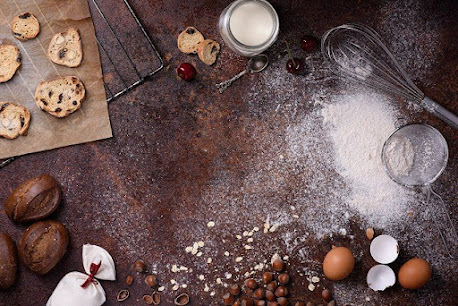CRUMBS AND CRUSTS
Welcome to "Crumbs and Crusts" , where every bake tells a story and every crumb is cherished! I’m Teesta , a passionate home baker dedicated to exploring the art and science of baking. Here, you'll find a delightful mix of tried-and-true recipes, innovative baking experiments, and tips to perfect your own creations.
From the flaky layers of a perfectly baked croissant to the gooey center of a decadent brownie, my goal is to share the joy of baking with you. Whether you're a seasoned baker or just starting out, "Crumbs and Crusts" is your go-to destination for all things sweet, savory, and utterly delicious.
The logo for "Crumbs and Crusts" is a delightful representation of the blog's essence. The name is styled in a charming, handwritten font that evokes the warmth and personal touch of homemade baking. The word "Crumbs" is emphasized with a sprinkle of crumbs falling from the letters, capturing the playful and inviting nature of the blog. "Crusts" is complemented with a subtle illustration of a pie crust or a bread loaf, highlighting the artisanal aspect of baking. The color palette features warm, earthy tones reminiscent of golden-brown baked goods, creating a cozy and appetizing visual appeal that invites readers to indulge in the blog's content.
The Craft of Baking is Understanding Ingredients
we need to understand the roles Roles of Flour, Yeast, Sugar, and Butter
1)Flour
Flour is the foundation of most baked goods, providing structure and texture. It's made from ground grains, with wheat flour being the most common. The type of flour used (e.g., all-purpose, bread, cake, whole wheat) affects the final product:
- All-purpose flour : Versatile and suitable for many recipes, providing a balanced protein content.
- Bread flour : Higher protein content (gluten), ideal for yeasted breads that need strong structure.
- Cake flour : Lower protein content, resulting in tender and delicate baked goods like cakes and pastries.
- Whole wheat flour : Contains the whole grain, offering a denser texture and richer flavor, with more nutrients and fiber.
2) Yeast
Yeast is a leavening agent crucial for bread and other baked goods that need to rise. It ferments sugars in the dough, producing carbon dioxide gas that creates air pockets, leading to a light and airy texture:
- Active dry yeast : Granular and needs to be dissolved in warm water before use.
- Instant yeast : Finer texture, can be mixed directly with dry ingredients, and acts faster than active dry yeast.
- Fresh yeast : Also known as cake yeast, it has a shorter shelf life but offers a more traditional flavor.
2)Sugar
Sugar plays multiple roles in baking, beyond just sweetness. It contributes to the texture, color, and moisture retention in baked goods:
- Granulated sugar : Commonly used, it helps in creaming processes, providing structure to cookies and cakes.
- Brown sugar : Contains molasses, adding moisture and a richer flavor, making it ideal for chewy cookies and certain cakes.
- Powdered sugar : Finely ground, used for icings, frostings, and dusting.
- Other sugars : Honey, maple syrup, and other sweeteners can add unique flavors and moisture.
3)Butter
Butter is a fat that adds flavor, tenderness, and richness to baked goods. It affects the texture and mouthfeel:
- Salted vs. unsalted : Unsalted butter is preferred in baking for better control of salt content.
- Creaming method : Butter beaten with sugar traps air, creating a light and airy texture in cakes and cookies.
- Laminate doughs : In pastries like croissants and puff pastry, butter is layered with dough to create flaky, crispy textures.
Importance of Ingredient Quality and Sourcing
Quality
The quality of ingredients directly impacts the flavor, texture, and appearance of baked goods. Using high-quality, fresh ingredients can make a significant difference:
- Flour : Freshly milled flour has better flavor and performance. Specialty flours like stone-ground or organic can offer superior taste and nutrition.
- Yeast : Fresh yeast ensures proper fermentation and rise. Old or improperly stored yeast can lead to flat, dense results.
- Sugar : Pure, unrefined sugars provide better flavor and consistency. High-quality brown sugar or artisanal sweeteners can enhance the taste.
- Butter : High-fat, butter offers richer flavor and better performance in baking due to its higher butterfat content.
Sourcing (organic )
Sourcing ingredients thoughtfully can enhance the quality of baked goods and support sustainable practices:
- Local ingredients : Sourcing flour, dairy, and other ingredients locally can ensure freshness and support local farmers and producers.
- Organic and non-GMO : Choosing organic and non-GMO ingredients can improve the quality and safety of baked goods while being environmentally friendly.
- Fair trade : Using fair trade sugar, chocolate, and other ingredients ensures ethical labor practices and supports sustainable farming.
By understanding the roles and importance of key ingredients like flour, yeast, sugar, and butter, bakers can better control the outcomes of their recipes and create high-quality, delicious baked goods.


.jpeg)



Comments
Post a Comment